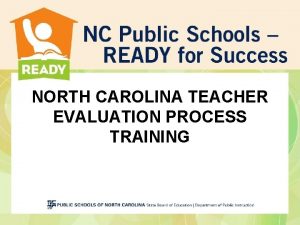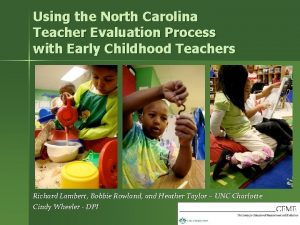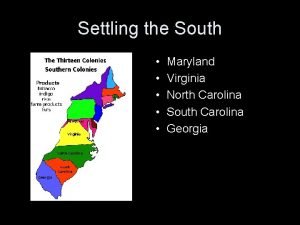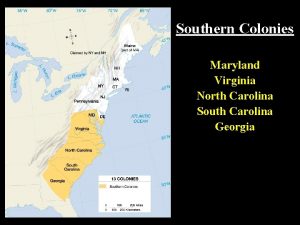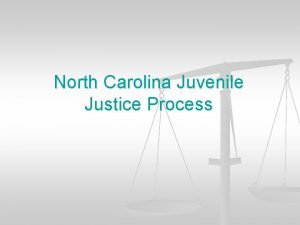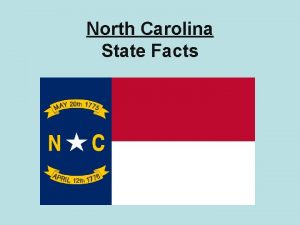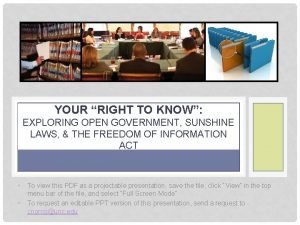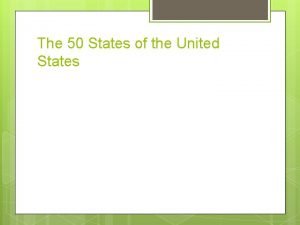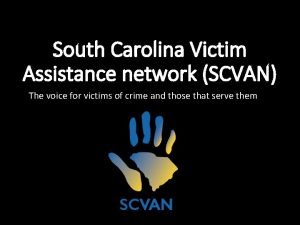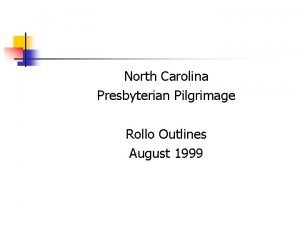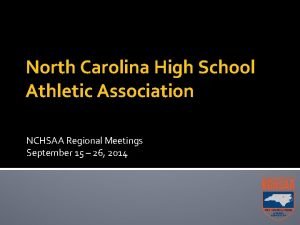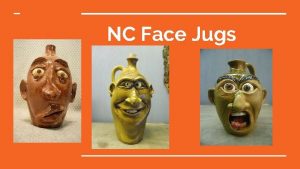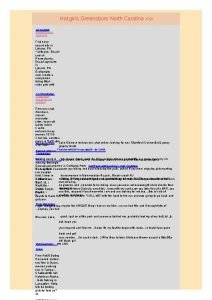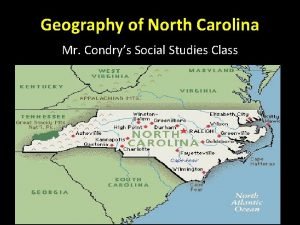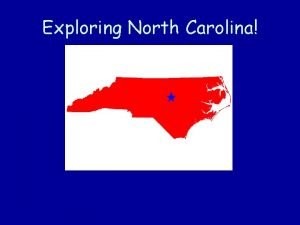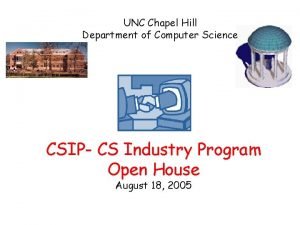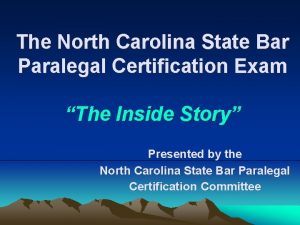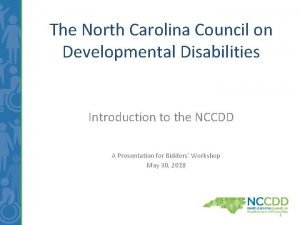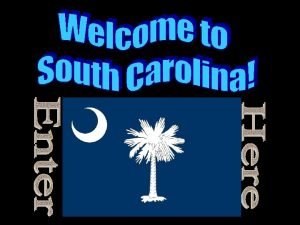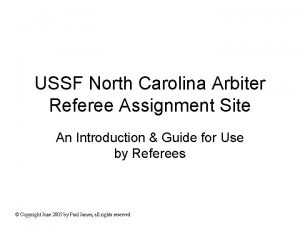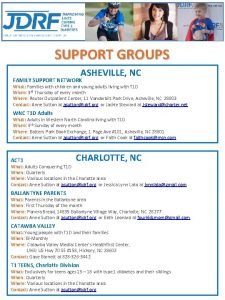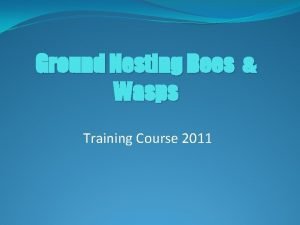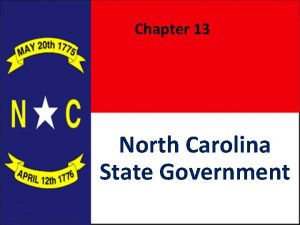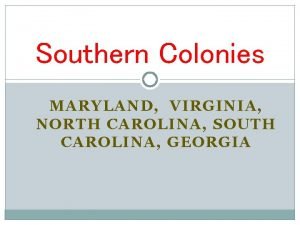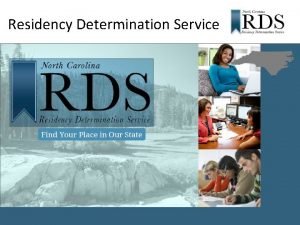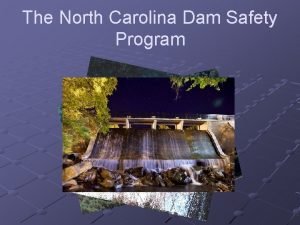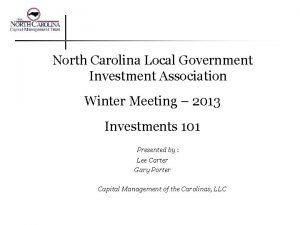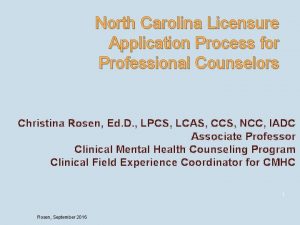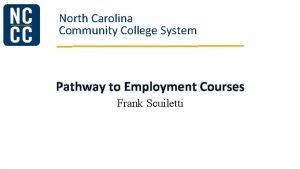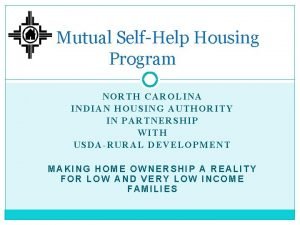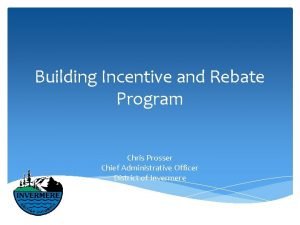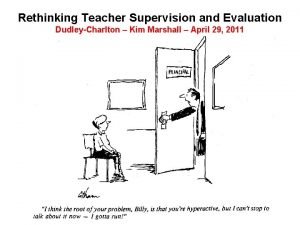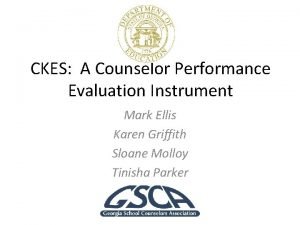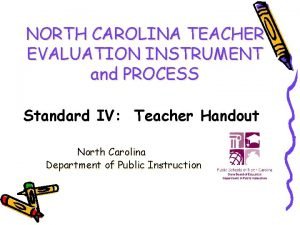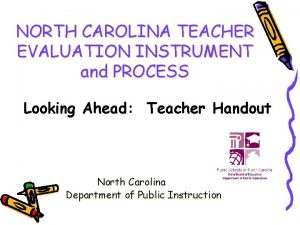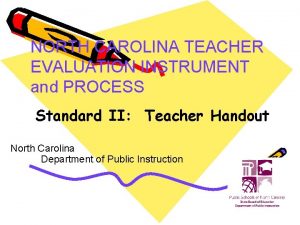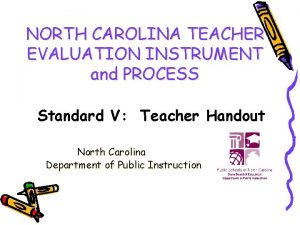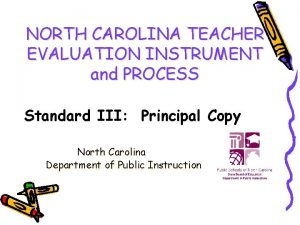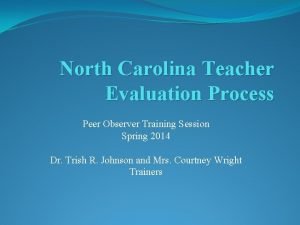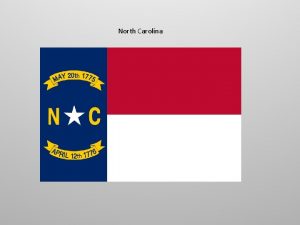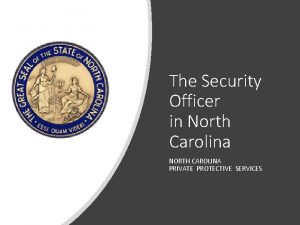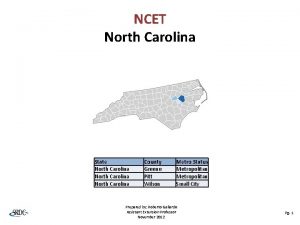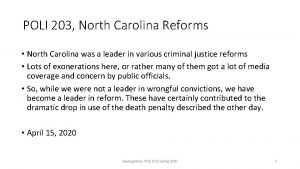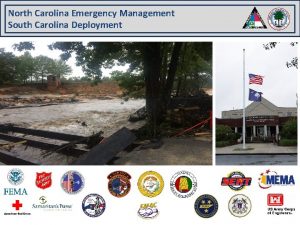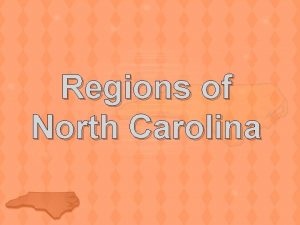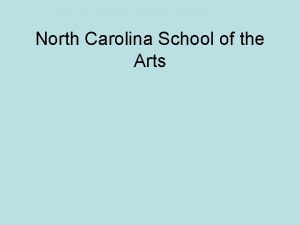NORTH CAROLINA TEACHER EVALUATION INSTRUMENT and PROCESS 2008

























































- Slides: 57

NORTH CAROLINA TEACHER EVALUATION INSTRUMENT and PROCESS 2008 -09 School Year 1

Future-Ready Students For the 21 st Century The guiding mission of the North Carolina State Board of Education is that every public school student will graduate from high school, globally competitive for work and postsecondary education and prepared for life in the 21 st Century. 2

To accomplish this mission, North Carolina Public Schools will: n Produce globally competitive students n Be led by 21 st century professionals n Be healthy and responsible n Leadership will guide innovation in NC Public schools n Be governed and supported by 21 st Century Systems 3

21 st Century Skills Framework 4

New Evaluation Systems to align with the Standards! • New principal evaluation system went into effect July 1, 2008 for all NC principals • 3000 principals and principal supervisors trained during the summer of 2008 5

North Carolina Professional Educator Evaluation Systems Their purpose is to support and promote effective leadership, quality teaching, and student learning. The design is a growth model to improve instruction and enhance professional practice. The evaluation instruments are based on the Framework for 21 st Century Learning and the Standards 6

They are flexible enough to be fair to teachers and school executives of varying levels of experience and in school settings. The rubrics are formative in nature based on a rating scale from developing through distinguished. Multiple data sources, artifacts, and evidence will be used in assessing educator performance. They will provide the basis for performance goals and professional development activities. 7

Phase I for the Teacher Evaluation System: 2008 -09 13 districts participating: Jones Orange Scotland Camden Newton-Conover Iredell/Statesville Elkin City Cherokee Alleghany Alexander Hertford Rutherford Wilson 8

Phase II: 2009 -10 • District teams trained regionally (Oct – Mar) • 50 districts volunteer for 8/09 implementation Phase III: 2010 -11 • Remaining districts begin implementation 8/10 9

Still to come: • Evaluation systems for Superintendents, Assistant Principals, Central Office Staff & other school personnel • Standards for School Boards 10

The teacher performance evaluation process will: q Serve as a measurement of performance for individual teachers. q Serve as a guide for teachers as they reflect upon and improve their effectiveness. q Serve as the basis for instructional improvement. q Focus the goals and objectives of schools and districts as they support, monitor, and evaluate their teachers. 11

The teacher performance evaluation process will: q Guide professional development programs for teachers. q Serve as a tool in developing coaching and mentoring programs for teachers. q Enhance the implementation of the approved curriculum. q Inform higher education programs as they develop the content requirements for higher education programs. 12

Performance Rating Scale n Developing – Demonstrated adequate growth but did not demonstrate competence on standard(s) of performance n Proficient – Demonstrated basic competence on standard(s) for performance n Accomplished – Exceeded basic competence on standard(s) of performance most of the time 13

Performance Rating Scale n n n Distinguished – Consistently and significantly exceeded basic competence on standard(s) of performance Not Demonstrated – Did not demonstrate competence on, or adequate growth toward, achieving standard(s) of performance [NOTE: If the “Not Demonstrated” rating is used, the evaluator must comment about why it was used. ] 14

Teacher Responsibilities: n Know and understand the North Carolina Professional Teaching Standards n Understand the North Carolina Teacher Evaluation Process n Prepare for and fully participate in each component of the evaluation process 15

Teacher Responsibilities (Cont. ): n Gather data, artifacts, evidence to support performance in relation to standards and progress in attaining goals. n Develop and implement strategies to improve personal performance/attain goals in areas identified individually or collaboratively identified. 16

Principal/AP Responsibilities o Know and understand the North Carolina Professional Teaching Standards o Participate in training to understand implement the Teacher Evaluation Process. o Supervise the Teacher Evaluation Process and ensure that all steps are conducted according to the approved process. 17

Principal/AP Responsibilities Cont. o Identify the teacher’s strengths and areas for improvement and make recommendations for improving performance. o Ensure that the contents of the Teacher Summary Evaluation Report contain accurate information accurately reflect the teacher’s performance. o Develop and supervise implementation of action plans as appropriate. 18

NC Standards for Teachers n Standard 1: Teachers demonstrate leadership n Standard 2: Teachers establish a respectful environment for a diverse population of students n Standard 3: Teachers know the content they teach n Standard 4: Teachers facilitate learning for their students n Standard 5: Teachers reflect on their practice 19

Gallery Walk of Standards with Informal Discussion 20

Standard I: Teachers demonstrate leadership. A. Teachers lead in their classrooms: üTake responsibility for all students’ learning üCommunicate vision to students üUse data to organize, plan, and set goals üUse a variety of assessment data throughout the year to evaluate progress üEstablish a safe and orderly environment üEmpower students 21

Standard I: Teachers demonstrate leadership. B. Teachers demonstrate leadership in the school: üWork collaboratively with all school personnel to create a professional learning community üAnalyze data üDevelop goals and strategies through the school improvement plan üAssist in determining school budget and professional development üParticipate in hiring process üCollaborate with colleagues to mentor and support teachers to improve effectiveness 22

Standard I: Teachers demonstrate leadership. C. Teachers lead the teaching profession: ü Strive to improve the profession ü Contribute to the establishment of positive working conditions ü Participate in decision-making structures ü Promote professional growth 23

Standard I: Teachers demonstrate leadership. D. Teachers advocate for schools and students: ü Advocate for positive change in policies and practices affecting student learning ü Participate in the implementation of initiatives to improve education 24

Standard I: Teachers demonstrate leadership. E. Teachers demonstrate high ethical standards: üDemonstrate ethical principles üUphold the Code of Ethics and Standards for Professional Conduct 25

Standard I: Reflection n Study the performance elements listed under Standard I. Consider and discuss specific teacher behaviors that would align with each of the standards. n Notice what seems to be a new or different behavior expected of teachers. n List the brainstormed teacher behaviors on post-it notes and place them beside the standards where they best align. 26

Standard II: Teachers establish a respectful environment for a diverse population of students. A. Teachers provide an environment in which each child has a positive, nurturing relationship with caring adults: üEncourage an environment that is inviting, respectful, supportive, inclusive, and flexible 27

Standard II: Teachers establish a respectful environment for a diverse population of students. B. Teachers embrace diversity in the school community and in the world: üDemonstrate knowledge of diverse cultures üSelect materials and develop lessons that counteract stereotypes and incorporate contributions üRecognize the influences on a child’s development, personality, and performance üConsider and incorporate different points of view 28

Standard II: Teachers establish a respectful environment for a diverse population of students. C. Teachers treat students as individuals: ü Maintain high expectations for all students ü Appreciate differences and value contributions by building positive, appropriate relationships 29

Standard II: Teachers establish a respectful environment for a diverse population of students. D. Teachers adapt their teaching for the benefit of students with special needs: ü Collaborate with specialists ü Engage students and ensure they meet the needs of their students through inclusion and other models of effective practice 30

Standard II: Teachers establish a respectful environment for a diverse population of students. E. Teachers work collaboratively with the families and significant adults in the lives of their students: ü Improve communication and collaboration between the school and the home and community ü Promote trust and understanding and build partnerships with school community ü Seek solutions to overcome obstacles that prevent family and 31 community involvement

Standard II: Reflection n Study the performance elements listed under Standard II. Consider and discuss specific teacher behaviors that would align with each of the standards. n Notice what seems to be a new or different behavior expected of teachers. n List the brainstormed teacher behaviors on post-it notes and place them beside the standards where they best align. 32

Standard III: Teachers know the content they teach. A. Teachers align their instruction with the North Carolina Standard Course of Study: ü Teach the North Carolina Standard Course of Study ü Develop and apply strategies to make the curriculum rigorous and relevant ü Develop literacy skills appropriate to specialty area 33

Standard III: Teachers know the content they teach. B. Teachers know the content appropriate to their teaching specialty: ü Know subject beyond the content they teach ü Direct students’ curiosity into an interest in learning 34

Standard III: Teacher know the content they teach. C. Teachers recognize the interconnectedness of content areas/disciplines: ü Know links between grade/subject and the North Carolina Standard Course of Study ü Relate content to other disciplines ü Promote global awareness and its relevance 35

Standard III: Teachers know the content they teach. D. Teachers make instruction relevant to students: üIncorporate life skills which include leadership, ethics, accountability, adaptability, personal productivity, personal responsibility, people skills, self-direction, and social responsibility üDemonstrate the relationship between the core content and 21 st Century content that includes global awareness; financial, economic, business and entrepreneurial literacy; civic literacy; and health and wellness awareness 36

Standard III: Reflection n Study the performance elements listed under Standard III. Consider and discuss specific teacher behaviors that would align with each of the standards. n Notice what seems to be a new or different behavior expected of teachers. n List the brainstormed teacher behaviors on post-it notes and place them beside the standards where they best align. 37

Standard IV: Teachers facilitate learning for their students. A. Teachers know the ways in which learning takes place, and they know the appropriate levels of intellectual, physical, social, and emotional development of their students: üKnow how students think and learn üUnderstand the influences on student learning and differentiate instruction üKeep abreast of evolving research üAdapt resources to address the strengths and weaknesses of 38 students

Standard IV: Teachers facilitate learning for their students. B. Teachers plan instruction appropriate for their students: üCollaborate with colleagues üUse data for short and long range planning üEngage students in the learning process üMonitor and modify plans to enhance student learning üRespond to cultural diversity and learning needs of students 39

Standard IV: Teachers facilitate learning for their students. C. Teachers use a variety of instructional methods: üChoose methods and materials as they strive to eliminate achievement gaps üEmploy a wide range of techniques using information and communication technology, learning styles, and differentiated instruction 40

Standard IV: Teachers facilitate learning for their students. D. Teachers integrate and utilize technology in their instruction: üKnow appropriate use of technology to maximize student learning üHelp students use technology to learn content, think critically, solve problems, discern reliability, use information, communicate, innovate and collaborate 41

Standard IV: Teachers facilitate learning for their students. E. Teachers help students develop critical thinking and problem-solving skills: üEncourage students to ask questions, think creatively, develop and test innovative ideas, synthesize knowledge and draw conclusions üHelp students exercise and communicate sound reasoning; understand connections; make complex choices; and frame, analyze, and solve problems 42

Standard IV: Teachers facilitate learning for their students. F. Teachers help students work in teams and develop leadership qualities: üTeach the importance of cooperation and collaboration üOrganize learning teams in order to help students define roles, strengthen social ties, improve communication and collaborative skills, interact with people from different cultures and backgrounds, and develop leadership qualities 43

Standard IV: Teachers facilitate learning for their students. G. Teachers communicate effectively: üCommunicate clearly with students in a variety of ways üAssist students in articulating thoughts and ideas clearly and effectively 44

Standard IV: Teachers facilitate learning for their students. H. Teachers use a variety of methods to assess what each student has learned: üUse multiple indicators, both formative and summative, to evaluate student progress üUse assessment systems to inform instruction and demonstrate evidence of students’ 21 st Century knowledge, skills, performance, and dispositions. üProvide opportunities for self-assessment 45

Standard IV: Reflection n Study the performance elements listed under Standard IV. n Brainstorm 2 -3 specific behaviors a teacher might use to demonstrate each of the standards. n List the brainstormed teacher behaviors on post-it notes and place them beside the standards where they best align. 46

Standard V: Teachers reflect on their practice. A. Teachers analyze student learning: ü Think systematically and critically about learning in their classroom: why learning happens and what can be done to improve student achievement ü Collect and analyze student performance data to improve effectiveness 47

Standard V: Teachers reflect on their practice. B. Teachers link professional growth to their professional goals: ü Participate in continued, high quality professional development 48

Standard V: Teachers reflect on their practice. C. Teachers function effectively in a complex, dynamic environment: ü Actively investigate and consider new ideas that improve teaching and learning ü Adapt practice based on data 49

The Evaluation Rubric • Used to record principal ratings on teacher observations • Used by the teacher in selfassessment • Used to document end of year ratings based on all evaluation activities 50

The Evaluation Rubric • Levels are cumulative across the rows of the rubric • A proficient teacher must exhibit all the skills listed in the developing column • If “not demonstrated” column is chosen, a comment must be made. 51

Rubric Reflection • Select and review the rubric for one of for standards. • Discuss with your colleague: – What is the break point between each level? – What questions do you have about the rubric? • Note any questions or concerns. 52

Definitions: n. Artifact – A product resulting from a teacher’s work (a natural by-product, not a newly created document) n n Possible Artifacts: n Professional Development School Improvement Plan n Student Work School Improvement n National Board Team Certification North Carolina n PTSA Teacher Working n Professional Learning Conditions Survey Communities (PLC) Student Achievement n Lesson Plans Data n Student Dropout Data 53

Definitions n Beginning Teacher - Teachers who are in their first three years of teaching and who hold a Standard Professional 1 License n Probationary Teacher – Teachers who have not obtained Career Status in their district n Career Status Teachers –Teachers who have been granted Career Status in their district n Formal Observation – an observation of a teacher’s performance for a minimum of 45 minutes or one complete lesson 54

Definitions n Informal Observation – An observation of a teacher for a minimum of 20 minutes n North Carolina Teacher Rubric – A composite matrix of the standards, elements and descriptors of the North Carolina Standards for Teachers n Performance Standard – The distinct aspect of leadership or realm of activities which form the basis for the evaluation of a teacher n Performance Elements – The sub-categories of performance embedded within the standard 55

Definitions n Performance Descriptors – The specific performance responsibilities embedded within the components of each performance standard n Performance Goals - Goals for improvement in professional practice based on the self-evaluation and/or supervisor recommendation 56

Definitions n School Executives – Principals and assistant principals licensed to work in North Carolina n Self-assessment – Personal reflection about one’s professional practice to identify strengths and areas for improvement (conducted w/out input from others) n Summary Evaluation Form – A composite assessment of the teacher’s performance based on the evaluation rubric and supporting evidence 57
 South carolina teacher evaluation system
South carolina teacher evaluation system Randa teacher evaluation
Randa teacher evaluation What is this image
What is this image Maryland virginia north and south carolina and georgia
Maryland virginia north and south carolina and georgia Virginia, maryland, north carolina, south carolina, georgia
Virginia, maryland, north carolina, south carolina, georgia Virginia, maryland, north carolina, south carolina, georgia
Virginia, maryland, north carolina, south carolina, georgia North carolina juvenile justice process
North carolina juvenile justice process 2008 2008
2008 2008 North carolina state mammal
North carolina state mammal Passive instruments
Passive instruments North carolina sunshine laws
North carolina sunshine laws North carolina's state motto
North carolina's state motto Nc victim assistance network
Nc victim assistance network Packingham v. north carolina
Packingham v. north carolina Nc presbyterian pilgrimage
Nc presbyterian pilgrimage Nc state fruit
Nc state fruit Nchsaa wrestling regionals
Nchsaa wrestling regionals North carolina landmarks
North carolina landmarks Ugly jugs history
Ugly jugs history Local sluts greensboro nc
Local sluts greensboro nc Geography of north carolina
Geography of north carolina Exploring north carolina
Exploring north carolina Unc hematology oncology
Unc hematology oncology Unc chapel hill computer science
Unc chapel hill computer science Paralegal certification nc
Paralegal certification nc Nc council on developmental disabilities
Nc council on developmental disabilities Lighthouses in nc map
Lighthouses in nc map North carolina geographic regions
North carolina geographic regions North carolina digital government summit
North carolina digital government summit Arbiter referee login
Arbiter referee login Family support network of north carolina
Family support network of north carolina Landform regions of south carolina
Landform regions of south carolina Discover north carolina's river basins
Discover north carolina's river basins North carolina medical examiner toxicology
North carolina medical examiner toxicology North carolina land of contrasts
North carolina land of contrasts North carolina state university
North carolina state university Chapter 13: north carolina state government
Chapter 13: north carolina state government Who founded north carolina
Who founded north carolina North carolina referee association
North carolina referee association North carolina residency determination service
North carolina residency determination service Why was north carolina founded
Why was north carolina founded Who founded north carolina
Who founded north carolina North carolina dam safety
North carolina dam safety Surgerync com
Surgerync com Local government investment pool services north carolina
Local government investment pool services north carolina Nbclpc
Nbclpc North carolina community college system jobs
North carolina community college system jobs Mutual self help housing
Mutual self help housing Mcnc north carolina
Mcnc north carolina Prosser submersible pump north carolina
Prosser submersible pump north carolina North carolina biotech companies
North carolina biotech companies Swot analysis in school improvement plan
Swot analysis in school improvement plan North east and cumbria ics
North east and cumbria ics North and south lesson 3 southern cotton kingdom
North and south lesson 3 southern cotton kingdom Kim marshall rubric
Kim marshall rubric Aahrpp evaluation instrument
Aahrpp evaluation instrument Instrument for curriculum evaluation
Instrument for curriculum evaluation Ckes
Ckes
